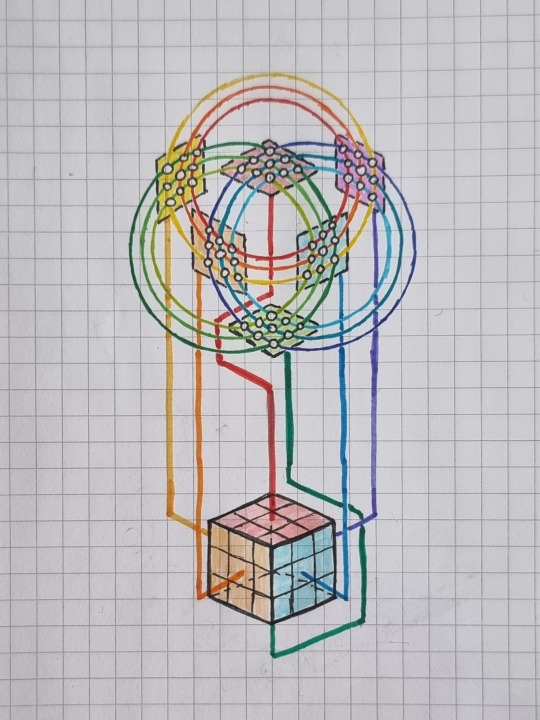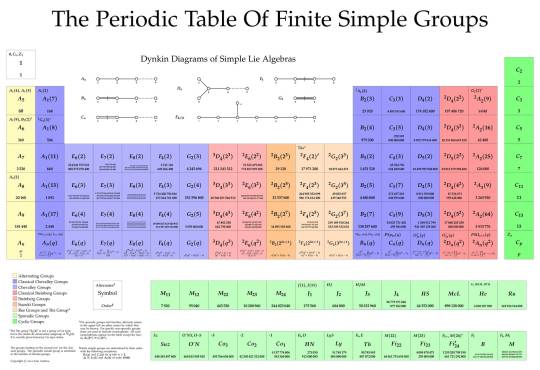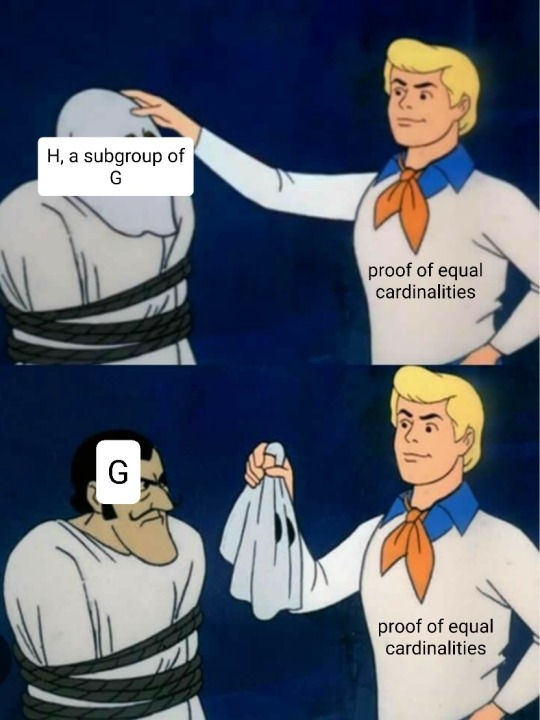#group theory
Text

Visualization of the Rubik's cube
#permutation#permutations#groups#group theory#rubiks cube#rubikscube#math#mathematics#math visualization#visualization#knottys math#math stuff#mathy stuffy#cube#hexahedron#combinatorics
14K notes
·
View notes
Text
now if you thought "group" is an unhelpful and nondescriptive name for a mathematical concept. just remember that the broader category of mathematical concepts that groups belong to is called, a "category". so it could always be worse
994 notes
·
View notes
Text

#tabby graphs#cats#math#group theory#i dont actually fully understand group theory#this seemed like a funny graph to turn catty#graphs
845 notes
·
View notes
Text
"I was told that generators in the braid group were their own inverse," I said, double-crossed.
263 notes
·
View notes
Text
Only in mathematics will someone say something like "the empty word"
105 notes
·
View notes
Text
One of students jokingly said something, when we were just talking about getting started learning math, about learning "the arcane secrets of the universe". There's only one piece of math I know that actually feels like an arcane secret of the universe to me, and it's the existence of the exceptional outer automorphism of S_6.
101 notes
·
View notes
Text
Criteria for a group of friends
1. You associate with each other
2. You all share an identity
3. Nobody can leave
4. Everyone has an opposite person to balance them out
It's helpful if you all commute together, but that's not a necessity.
948 notes
·
View notes
Text
The phrase "give a single fuck" implies fucks form part of a group with a multiplicative identity. However, they are not commutative because giving a fuck before an event has a different effect than giving a fuck afterwards. This also implies that there is a multiplicative inverse to giving a fuck, which in general can be shown to be true.
Thus, fucks can form a non-commutative multiplicative group.
#mathpost#mathblr#group theory#maths posting#I dont know anything about group thoery and made all of this up
141 notes
·
View notes
Text
Currently TAing group theory so here's a fun little elementary problem I gave my students: Prove that any finite group with more than 2 elements has a nontrivial automorphism. The finiteness condition is not really necessary but whatever.
Feel free to reblog with your solution!
138 notes
·
View notes
Text
(from June 2023)
Note: In runtime formulas, computer scientists don't ignore the constant term because it "doesn't have a big effect". They ignore it because they're trying to establish an upper bound for problems of every size. (This is a common misconception about the big-O notation used in computer science.)
21 notes
·
View notes
Text
@anicemyth you're about to make us soooo autistic about this you don't even know bless you
so group theory: this is a very rudimentary explanation but in mathematics a group describes all the ways a structure can be symmetric aka every operation or transformation that can be done on a structure while still it remains unchanged. for example a symmetry of an equilateral triangle would be mirror flipping it on its axis or rotating it 120 or 240 degrees. the untransformed state of the structure (e.g. rotating said triangle by 0 or 360 degrees) is also counted as one of the total symmetries within the group. There's a lot of detail in the defining of this regarding the arithmetical and algebraic behavior of groups that the resources I'm going to add at the end will surely do a better job of than I could.
A group of these symmetries can be broken up into "building blocks" similarly to how an integer can be broken down into its prime factors. These building blocks of groups are known as simple groups. putting aside the fact that there are infinite simple groups bc let's not even go there - the monster group is one of the finite simple groups.
through an incredible mathematical undertaking it has been proven that we have discovered all the possible finite simple groups that can exist. they fall into categories based on their properties and this categorization is depicted in something that looks a lot like a periodic table of elements:

in the colored columns are the 18 assorted categories of group - cyclic, alternating, etc, but at the bottom the 2 rows in light green show the sporadic groups which are 26 groups that do not fall in any of the above categories. at the bottom right is the monster group.
the reason why this is crazy - the numbers listed at the bottom of each box there are the total number of symmetries contained within the group. for an equilateral triangle like I mentioned above you get 6 symmetries including both rotational and reflectional symmetries and including the baseline state of the triangle without any transformation having been done on it.
The monster group? Contains about. 8 x 10^53 symmetries. That is
808,017,424,794,512,875,886,459,904,961,710,757,005,754,368,000,000,000
symmetries. what the fuck. both massive and specific. if that triangle with 6 symmetries is 2 dimensional - with this many symmetries how big must this monstrous object be?
196,883 dimensions.
in addition to that the monster group actually contains (including itself) 20 of those 26 sporadic groups. (Fun fact those groups contained within the monster have been dubbed the Happy Family with the 6 outliers being named the Pariahs lmao). it's notable also bc it is very difficult to represent it concisely compared to other finite simple groups including the rest of the sporadics.
so it's just this.... thing. that is out there. we know what it is, we know its incredibly specific parameters, but of course we don't know WHY it's there or WHY those are the numbers you arrive at (if thats even a reasonable question to ask), it looks very arbitrary but it is ultimately a fundamental mathematical entity regardless of how inelegant it may seem, the universe is an interesting place
this weird abstract yet very specific structure has connections to other fields of mathematics - it has a connection to modular functions as described by the monstrous moonshine conjecture. yes it's actually called that and it is waaay above my paygrade but this somehow connects to a 24-dimensional variant of string theory (note I absolutely hate string theory for unrelated reasons but the mathematics of it is very interesting) in some way.
in short there exists an incredibly high dimensional object with an obscene number of symmetries that can can be used in tandem with something from a seemingly totally unrelated area of mathematics (the modular j-function) to describe a physics theory. ?????????? they called it moonshine bc they thought it was an absolutely batshit thing to even consider but apparently it works
that is my best attempt at explaining this so here are some resources I really recommend:
youtube
youtube
additionally I'd like to just plug John Conway as a whole here he's in the first video linked talking about his work regarding the monster group and the moonshine conjecture. you can find him on the channel speaking on other topics including the game of life which is an unrelated but very interesting cellular automaton that is available free online to be played with. his group theory work is what stands out to me though, he sadly passed of covid a few years back at an old age but he is one of my favorite mathematicians of all time not only because of his work but also because he just seems like a chill fucking guy
my fanciful conclusion is like. this Thing evokes in my mind images of angels or eldritch horrors or what have you. vast and incomprehensible it dwells in a space so complex it defies any human understanding beyond the mathematics used to describe it. it is beautiful and unthinkable and perhaps i want to kiss it. the end
(If anyone with a better mathematical background than us which is not at all a high bar to set wishes to add to this please do!)
19 notes
·
View notes
Text

idea I had for notation for the symmetric group S4 (the rotational symmetries of a cube, the rotations and reflections of a tetrahedron, the permutations of a list of four objects, etc). this is the multiplication table for the "numbers" in this group, for example dr = z.
372 notes
·
View notes
Text

Sometimes abstract algebra escapes the ‘Abstract Algebra Box’ in my brain and invades older mathematical knowledge.
95 notes
·
View notes
Text

Image caption: Two images of Fred from Scooby-Doo unmasking a man dressed as a ghost. Fred is labeled "proof of equal cardinalities". The man dressed as a ghost is masked and labeled "H, a subgroup of G" in the first image. In the second image, the man dressed as a ghost is unmasked and labeled "G".
#mathematics#math jokes#group theory#ms mathematics#fred unmasking meme#cried for class#procrastination power
11 notes
·
View notes
Text
"I am being very normal" I say as for all elements in G my left and right cosets are equal
#maths posting#maths memes#lipshits posts#lipshits memes#I think i could have worded that better but oh well /lh#group theory
134 notes
·
View notes
Text
Rubiks' cube agent development decisions
This is just me thinking out loud.
I have decisions to make. I have built a code foundation that can generate Rubiks' cube data now and I also have a ginormous dataset (the strategic_game_cube by laion) sitting on my computer. It is extremely poorly optimized for space and they use the yellow side of the cube for the top smh. I liked the idea of using an existing dataset so that the length of the agents' solves could be compared against other agents' on the same dataset. However, I literally don't know of anyone else working on a Rubiks' cube solving agent.
Decision #1: Use strategic_game_cube dataset or custom dataset/training environment?
Then my next decision is how much more time do I spend in Rustland? Do I make what currently exists accessible from Python and just go for it? Do I make what currently exists usable from the TUI? Do I continue in Rust until I can't any longer? Do I make a fleshed out CLI tool so the steps to the process are reproducible? (Do I write tests... well, I suppose I should test things before I move on and assume that everything is working right... well, I added some things but they aren't really necessary for the primary objective, I just wanted to see if I could do them... well, actually they might be necessary for the loss function... I just don't want to have to add stuff to the TUI. I've tried so many different UI libraries and I actually like HTML/CSS the best. I just need someone to teach me one UI library. Like a 5-hour lesson and then I think it would at least be intelligible, if not less annoying to make things go where I want them to.)
Hmmmm... I really don't want this to be another project that I started and abandoned, but I also really don't want to spend forever trying to expand the TUI so I can test the things I need to and then find out I'm not good enough to do it and then give up. If I spend forever procrastinating, I can't fail, right? The downside is that procrastinating eventually turns into forgetting which is the same as abandoning. So, *sigh* I don't currently have all the time in the world to spend on this project, but I will agree to spend 1 hour on the TUI to gauge the difficulty of testing the new feature. (I made a function that takes the (non-commutative) difference of two Rubiks' cubes, which is a thing you can do with group theory because 3x3x3 Rubiks' cubes are a subgroup of the S 48 group. I plan on using it to compare Rubiks' cube states along a path to see if longer segments of the path can be replace with shorter segments.)
Decision #2: Test or don't test? (Unfortunately, I know the answer to this one.)
Decision #3a: How to make the process accessible and reproducible?
Decision #3b: When to write the README.md and make the repo public?
#rust#codeblr#rustacean#programming#python#rubikscube#group theory#ai#rl#reinforcementlearning#neural network
3 notes
·
View notes